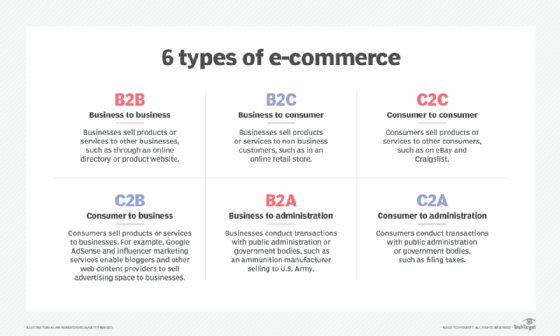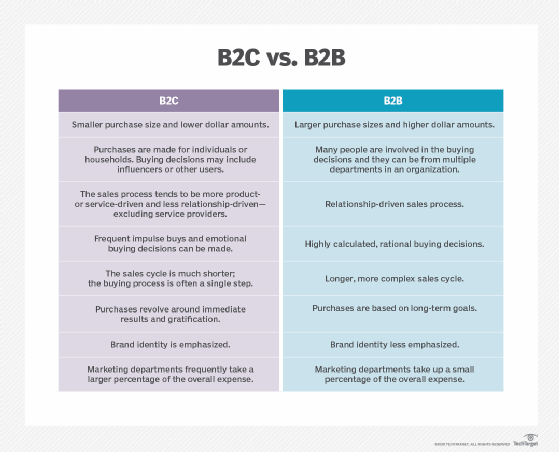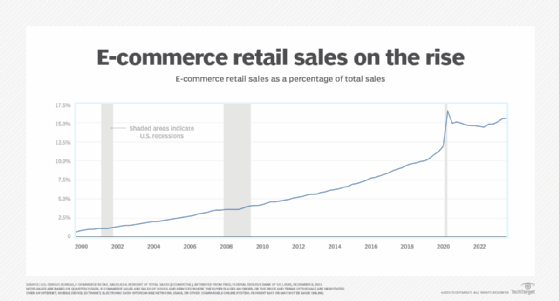B2C (business-to-consumer)
What is B2C (business-to-consumer)?
B2C, or business-to-consumer, is a retail model where products or services move directly from a business to the end user who has purchased the goods or services for personal use. It is often contrasted with the business-to-business (B2B) model, which involves exchanging goods and services between businesses instead of between businesses and consumers.
The B2C Business model applies to any business transaction where the consumer directly receives goods or services, such as small businesses and entrepreneurs, retail stores, restaurants and doctor's offices. B2C most often refers to e-commerce businesses, which use online platforms to connect their products with consumers.
Some B2C businesses use their platforms to market and sell their own products; others connect buyers to sellers, using content traffic to sell advertising spaces or restricting content to paid subscriptions. Popular B2C companies include Amazon, eBay, Meta, Netflix, The New York Times Co. and Uber.

How does B2C work?
B2C businesses sell goods and services directly to consumers. A consumer is an end user who buys a product or service for personal use. Though many businesses sell their own products, this is not a requirement for the B2C model; many B2C companies resell other businesses' products.
A B2C retail experience can be shopping at a local grocery store or buying new headphones from the Apple online retail store. A B2C service experience can be a visit to the doctor, treatments at a hair or nail salon, a meal at a restaurant or a ride purchased with the Uber app.
Types of B2C companies
Though the term B2C is frequently used to refer to retailers and marketplaces, it can also be applied to content and service providers. B2C businesses can vary significantly. Some businesses adopt a business model that combines different profit models, incorporating marketing and advertising as well as fee-based approaches.
Common types of e-commerce B2C companies include the following:
- Direct sellers. These are the most common e-commerce businesses; customers buy directly from online stores, such as Zappos.com, Ikea.com and Target.com.
- Intermediaries. Rather than offering their own products or services, these e-commerce companies offer a platform to connect buyers with independent sellers and resellers. Online intermediaries often profit by charging a small percentage of each sale from vendors. Consumers often use intermediaries because they offer lower prices. Examples include eBay, Etsy, Expedia, Facebook Marketplace and Poshmark.
- Advertising-based. These e-commerce companies use traffic-driving digital marketing strategies, such as content marketing and social media marketing, to connect shoppers with relevant advertisements for products and services. Advertising-based businesses profit from selling advertising space on websites and social media platforms. HuffPost is an example of this type of B2C company. Affiliate marketing is also an advertisement-based approach to B2C, in which a company partners with content creators to promote their product through blogs or social media posts.
- Community-based. Similar to advertising-based businesses, community-based companies use online communities focused on specific identities, interests and information. They use data they get from website users, such as demographic data and geographic location, to connect those users with targeted ads. Examples include social media sites like Facebook and online forums.
- Fee-based. These e-commerce businesses require a paid subscription in exchange for unrestricted access to their content, such as The Wall Street Journal, The New Yorker and Netflix.
Brick-and-mortar stores are another type of B2C business model. These businesses have a physical location where consumers can enter the store, touch and hold the merchandise, and buy products or services in person. These include traditional businesses such as restaurants, doctors' offices, J. Crew storefronts, car rental branches and hair salons.

B2C vs. B2B
The primary difference between the B2C and B2B business models is to whom the company sells. B2C businesses sell to consumers, while B2B companies sell to other businesses.
B2C
B2C is known for the following characteristics:
- The size and cost of each purchase are smaller.
- Individuals and households are often the buyers.
- Sales processes are product- or service-driven rather than relationship-driven.
- Buying decisions are often impulsive or emotional.
- The process is frequently one step.
- Immediate results and gratification drive sales.
- Brand identity is critical.
- Marketing accounts for more of the expense of each sale.
B2B
B2B transactions are between two businesses, such as wholesalers selling to retailers. They are known for the following characteristics:
- Transactions are often for higher dollar amounts and larger purchase sizes.
- Many people are involved in the buying decisions, including multiple departments in an organization.
- The sales process is frequently relationship-driven.
- These are rational, highly calculated buying decisions.
- The sales cycle is longer and more complex.
- Long-term goals drive purchases.
- A smaller percentage of the overall expense is from B2B marketing.

Considered purchases
B2C and B2B transactions can be similar when it comes to considered purchases, which are buying decisions that have higher degrees of risk and reward, both financially and emotionally. B2B transactions are nearly always considered purchases. However, only B2C transactions with high dollar amounts -- such as buying a new house or paying for a college education -- tend to be considered purchases.
B2C considered purchases frequently have the following characteristics:
- longer, more complex sales cycles;
- rationale-based buying decisions; and
- multiple decision-makers.
How is marketing different for B2C businesses?
Many B2C businesses, particularly ones with broad audiences, spend a significant amount of money on marketing. Video ads and commercials are frequently used in B2C marketing strategies because they can target wide audiences, appeal to emotions and increase brand awareness.
In contrast, B2B companies focus on marketing to specific clients. That approach makes broad advertising mediums -- such as print, TV and social media -- ineffective and expensive.
In addition, B2C marketing focuses on targeting users and buyers who match particular demographics. Cross-selling and up-selling can be a significant source of sales for B2C retailers, especially e-commerce businesses. They use website visitor and shopper data to create personalized shopping recommendations. However, sales lead management is practiced far less by B2C companies, as sales cycles tend to be short.
Unlike B2B companies, the marketing efforts of certain B2C companies in the retail space have started to focus on the customer experience (CX). CX focuses primarily on how customers shop, buy, unbox and use their products.
Benefits of B2C e-commerce
B2C e-commerce models have several potential benefits, including the following:
- Globalization. Larger-scale B2C businesses often have large target audiences. They use globalized advertisements and marketing campaigns that can reach millions of potential customers via the internet and social media.
- Low cost. E-commerce B2C models cut down on operational and physical infrastructure costs.
- Personalization. B2C businesses can directly market to consumer segments and niche target audiences, letting companies personalize their marketing for individual consumers.
- Customer experience management. Both online and brick-and-mortar businesses have complete control over user experiences. This control can lead to better customer service, increased cross-selling and customer loyalty.
- Customer data. Valuable customer data can strengthen a business's marketing efforts and provide details about users. This data can include sales conversion stats, email addresses, customer behavior patterns, geographic regions and psychographics.
- Booming business. B2C is one of the business models driving e-commerce's dramatic increase in sales in the last decade. According to the U.S. Census Bureau, e-commerce sales adjusted for seasonal variations in the third quarter of 2022 was 14.8% of total retail sales. That's almost 2.5 times the same figure in the third quarter of 2013.

Examples of B2C retailers
The following are some examples of B2C retailers.
Brick-and-mortar B2C retailers
- Costco
- H&M
- Walmart
Physical B2C retailers
- convenience stores
- doctors' offices
- hair and nail salons
- pet groomers
- restaurants
- spas
E-commerce B2C online retailers
- Airbnb
- Alibaba
- Amazon
- The Atlantic
- Baidu
- ebay
- Etsy
- HuffPost
- Ikea
- Netflix
- The New York Times Co.
- Poshmark
- Rakuten
- Uber
- Wayfair
- YouTube
- Zappos
B2C is one of many e-commerce models. Read up on the top 8 e-commerce marketing platforms to consider.







